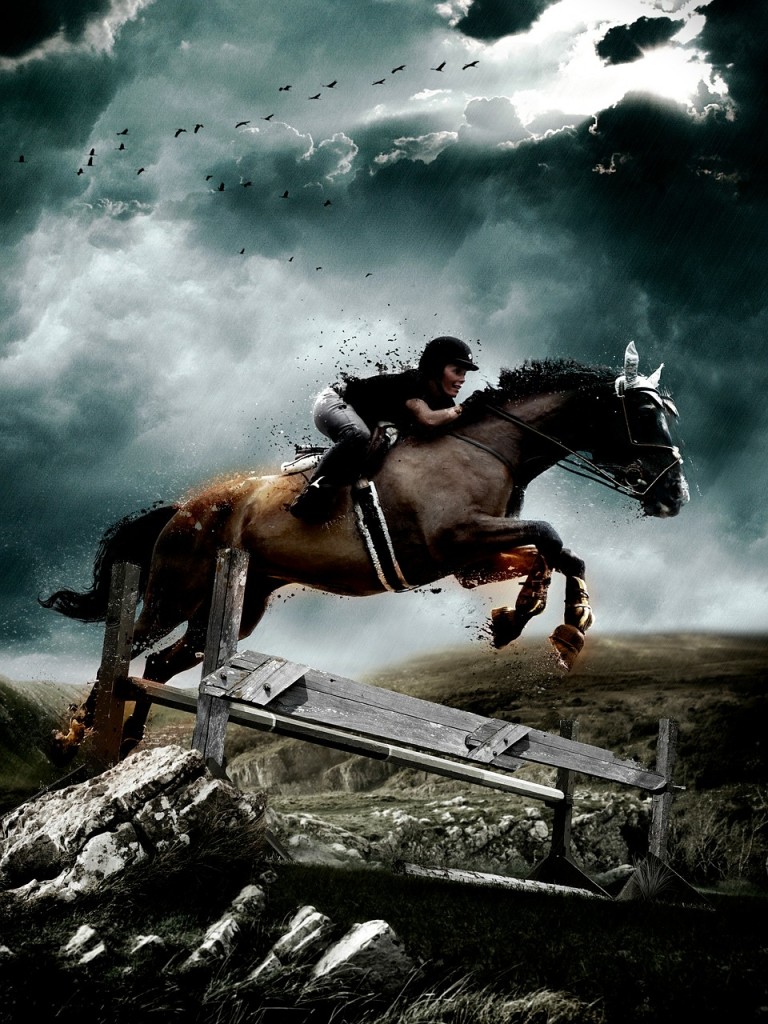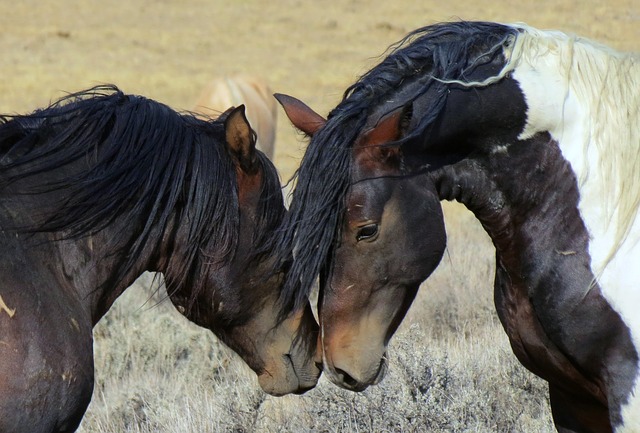In a natural or feral state, horses live in a herd. I know that is a well-known fact and it might seem too obvious to even mention. However, we often fault horses for behaviors that are both natural and instinctual.
We are often exposed to horses that have been born in a domestic setting and habituated to behaviors that are not instinctive or natural for horses. We come to believe that this is “normal” horse behavior, and label horses that are actually behaving more naturally as being “difficult” or having behavioral issues.
For survival, a horse in a natural state would never leave a herd unless forced to. As with other social animals, a horse finding him or herself alone in the wild would understand that this is a desperate and dangerous state and would try to become part of another herd or social group as quickly as possible.
Horse Nightmare
Horses born and raised in a domestic setting become conditioned to leave other horses. We remove foals from their mothers at a young age and often this is when they learn to overcome their instincts and accept leaving other horses even though this is unnatural for them. However, we need to understand that any horse that has not been separated from other horses on a regular basis will quite naturally object to being separated. All of his instincts will warn him that separation is a dangerous situation and he will do everything in his power to return to the safety of his companions. Any horse will tend to revert back to this natural behavior of seeking the herd when stressed or when introduced to a new and different situation.
Horses, like humans can learn to accept situations that they previously perceived as dangerous if they are exposed to the situation enough times. If someone were to put you in a race car and drive you at high speeds around a track, initially your body would react with adrenaline and other stress hormones. However, if you were to get in that race car every day for a couple of months, after awhile your adrenaline and stress response would become less and less. Eventually, if you did not have any accidents, your body would barely respond to this stimulus at all.
I’ve been told that horses learn to trust that their human handler will keep them safe, and this is why eventually they can be taught to be led or ridden away alone. I tend to believe that this is not actually true, but that horses simply through exposure learn that this situation they previously thought was dangerous is safe. Because of this, their bodies no longer respond by releasing adrenaline and other stress hormones when they leave the other horses. I’ve never been convinced that a horse weighing 1,000 lbs and able to run away from danger at 30 mph thought that I was keeping him safe. Conversely, I’ve noticed that when actual danger appears on the horizon, the horse does not hide behind me but instead makes his own decision about getting out of Dodge.
Horses will often follow us into situations they feel might be unsafe, but it is my belief this is due to the fact that we’ve taught them that they must follow us. My horses have been taught that when I am leading them, they will end up going in the direction I choose. If they ignore my initial cues, I am persistent about following through (like most horse owners), and the horse soon learns to go along with this human. It is not a matter of trust, but of training.
It seems important to me that we approach the common issue of the “herd bound/buddy sour” horse from this perspective: that this is the natural instinct of the horse and he is not doing anything wrong. It is up to us to teach the horse through multiple exposures that he will be safe if he goes off on his own, and condition his body so it does not release stress hormones when he leaves the herd.

Many people want a quick fix for this problem, but the horse cannot overcome the physiological reaction of his body all at once. You can’t get someone over a fear of elevators by shoving them into one a couple of times and then expecting that their heart will no longer race at the thought of getting into an elevator. Instead, it takes small, consistent steps to retrain the body’s fear reaction. Fortunately, the horse will not have the choice that many humans make for themselves, which is to avoid confronting a phobia altogether. But you also have to understand that even if a person conditions himself to riding up the elevator in his two story building, that might not mean he can easily transfer this to going up a high speed elevator in a high rise without fear. It is the same with the horse when moving to a new situation. He will revert back to his natural instinct.
The horse that will not be led away from his buddy or won’t ride away from the barn needs several things to happen if you want him to react calmly and consistently:
1) He must be exposed to going out on his own regularly. It can’t be something that only happens on a rare occasion.
2) He must not get injured or have a bad experience during this exposure. I’m not saying he must never get upset, but he can’t be allowed to cause himself physical pain or his instinctive fears will be reinforced.
3) Ideally, the time and distance from the area the horse feels is safe should be increased gradually enough that the horse remains mostly calm.
If the horse has not been taught that it is safe to be on his own, you will need to have a lot of patience or you will not have success. It is important to remember that horses can also sense your fear and stress, so if you let yourself get upset by this very natural horse behavior, you will have even more difficulty teaching your horse to be calm.
 A horse must overcome the physical response to separation anxiety before he can work on learning new things
A horse must overcome the physical response to separation anxiety before he can work on learning new things
My rescue horse, Halla spent 8 years turned out with a gelding. The two horses were kept together and rarely handled. When the horses were first rescued, they could not go ten feet away from each other without panicking, whinnying loudly and rearing. At first, I would walk one of them outside the barn where their stalls were, around a corner where they couldn’t see each other and then quickly back. After several days, we would go farther and farther down the driveway before going back toward the other horse. Short walks out alone turned into longer ones. We began mixing the two horses around with other horses in the turnouts, and at first rode them out together, but soon with other horses they were familiar with. After several months, Halla was able to go out on rides alone.
I’ve met horse owners who are afraid to ride their horses out on their own. In my experience, beginning with walks out alone, then walking out and riding back, and finally riding both ways will soon lead to a horse that is confident about riding alone. When I started with one of my mares, she ended up running for home on several occasions when she got rattled. One of these times I was on her back and unable to stop her, but on the other occasions I watched her departure from the ground. This sort of thing will discourage people. Yet with horses, consistency is key. If you keep at it, soon enough even a horse this insecure will gain enough bravery to face the world. My little mare goes all kinds of places alone now, with all types of riders.
Unlike many people, I see nothing wrong with a decision to avoid making your horse separate from his herd if you would rather work around it. If it is not a problem for you to lead the horse and ride the horse with his buddy or another friend, there’s no reason why he can’t remain happily in this natural state. You may need to keep a horse near when doing vet or farrier care, but that is often not too difficult. If one horse in a pair dies or must be sold, the other horse will have anxiety for a day or two and then will get over it. This situation happens in the wild, and horses can deal with it when they must.

